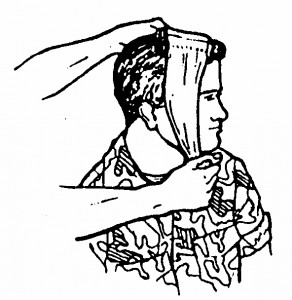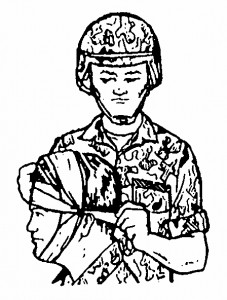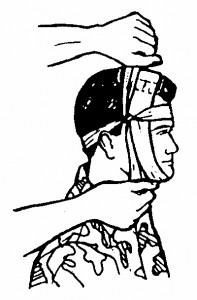a. Remove the field dressing from its wrappers, grasp a tail in each hand, hold the dressing directly over the wound, pull the dressing open, and place the white, sterile side of the dressing pad on the wound.
b. Place one hand on the dressing to keep it from slipping. If the casualty is able, you can have him assist by holding the dressing in place.
c. Grasp the near tail with the other hand.
d. Bring the tail down in front of the ear (figure 5-4), under the chin, up in front of the opposite ear, over the dressing, and to a point just above and in front of the first ear (about a one and one-fourth circle).

CAUTION: When passing a tail under the chin, make sure the tail remains wide and close to the front of the chin. This will keep the bandage from pressing against the casualty’s trachea and interfering with his breathing.
e. Remove your hand from the dressing and grasp the other (free) tail.
f. Bring the second tail down the opposite side of the face in front of the ear, under the chin, and up until it meets the first tail (about a three-fourths circle).
g. Cross the tails so each makes a 90 degree turn. The cross should be made slightly above and in front of the ear.
h. Bring one tail across the casualty’s forehead above the eyebrows until it is in front of the opposite ear (about a half circle). Bring the other tail back above the ear, low behind the head at the base of the skull, and up to a point above and in front of the opposite ear (about a half circle) where it meets the first tail (figure 5-5). Bringing the tail across the base of the skull keeps the bandage from slipping.

i. Tie the tails in a non-slip knot in front of and above the ear (figure 5-6) and tuck in any excess material.

(wound on top of head).
